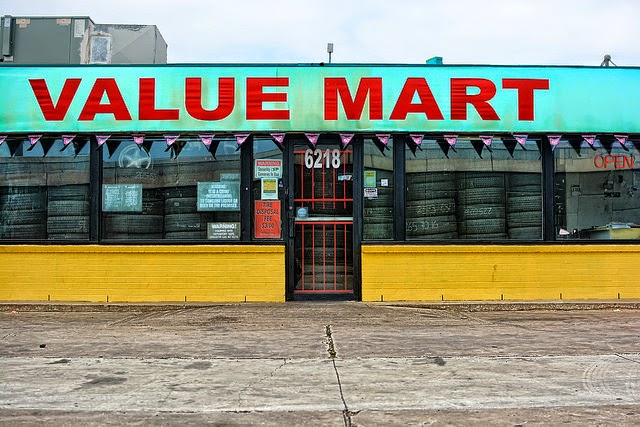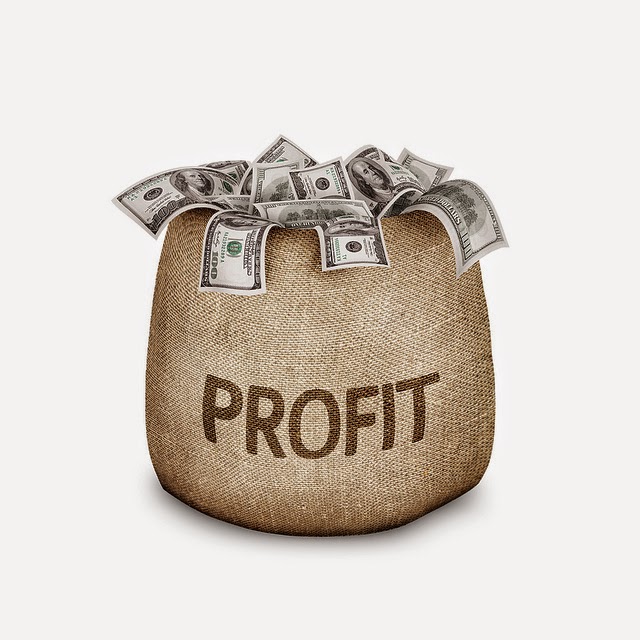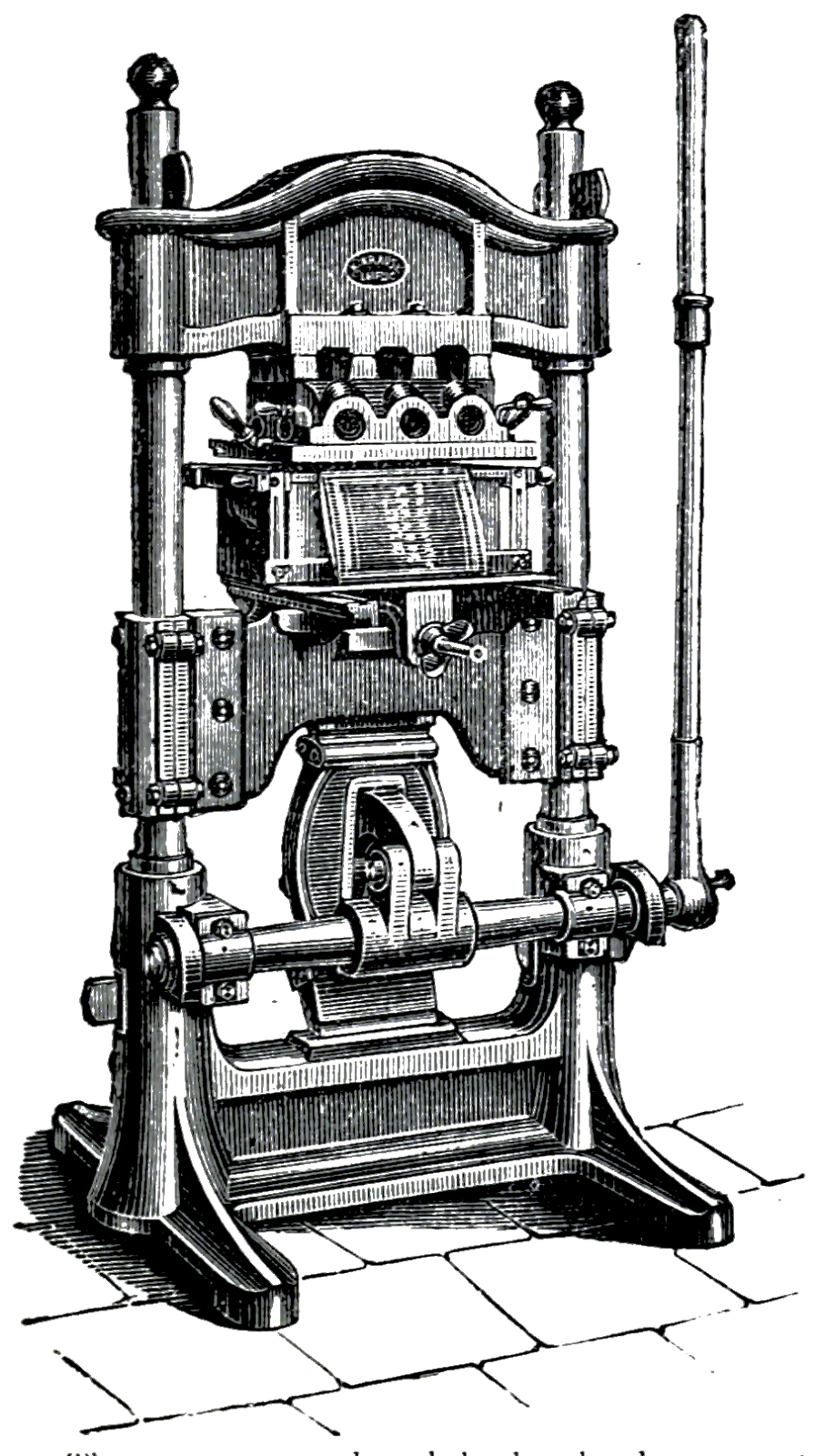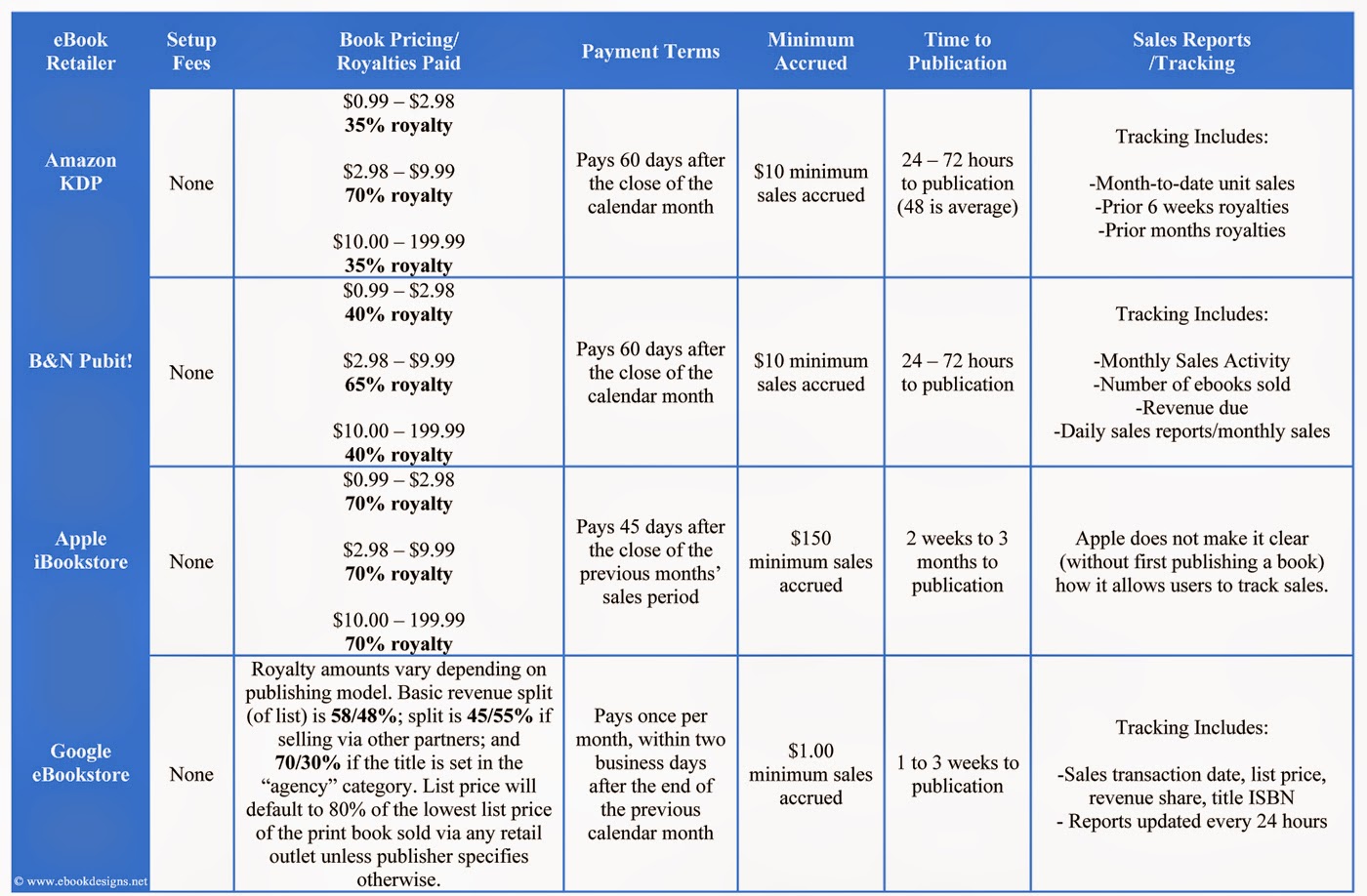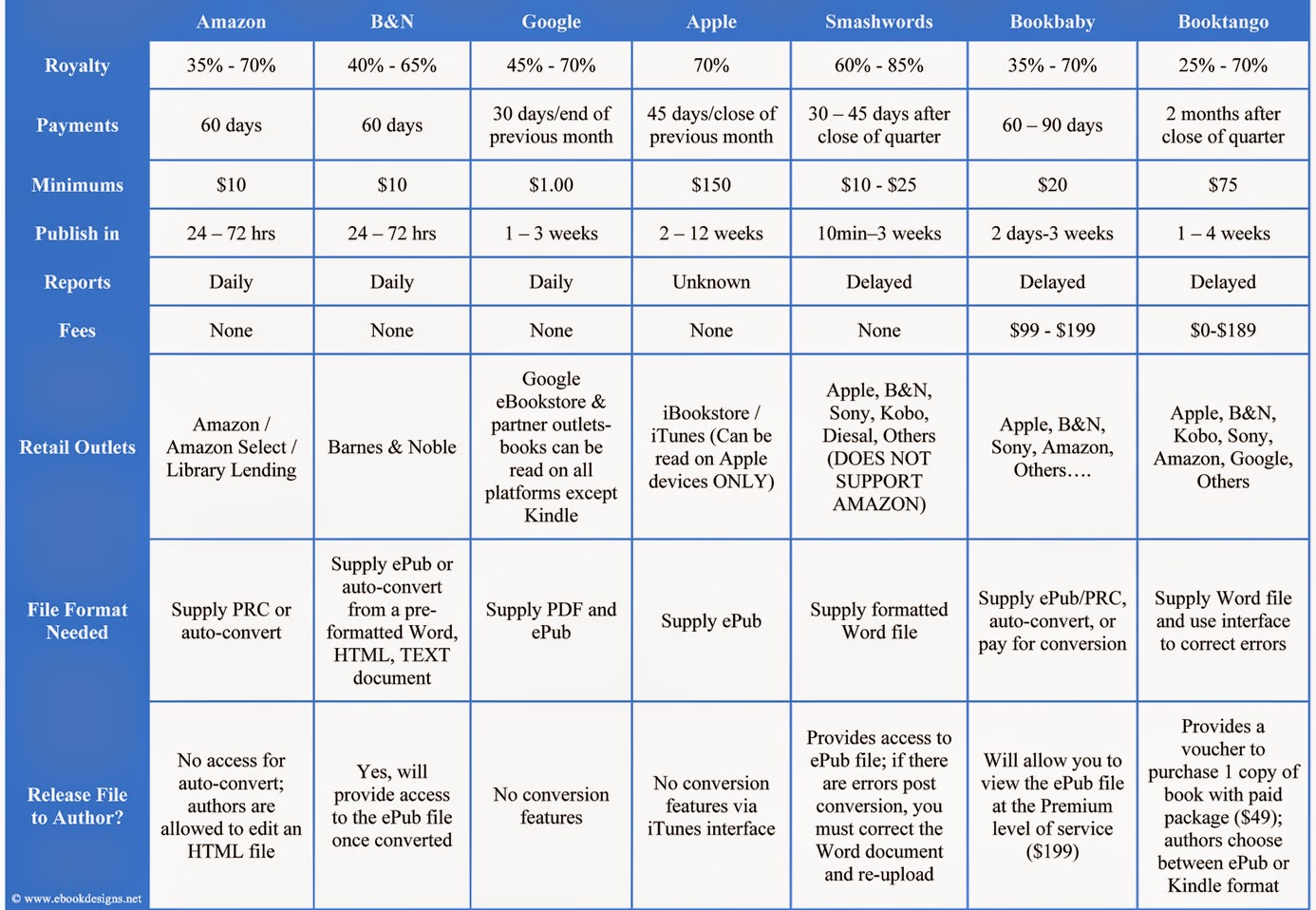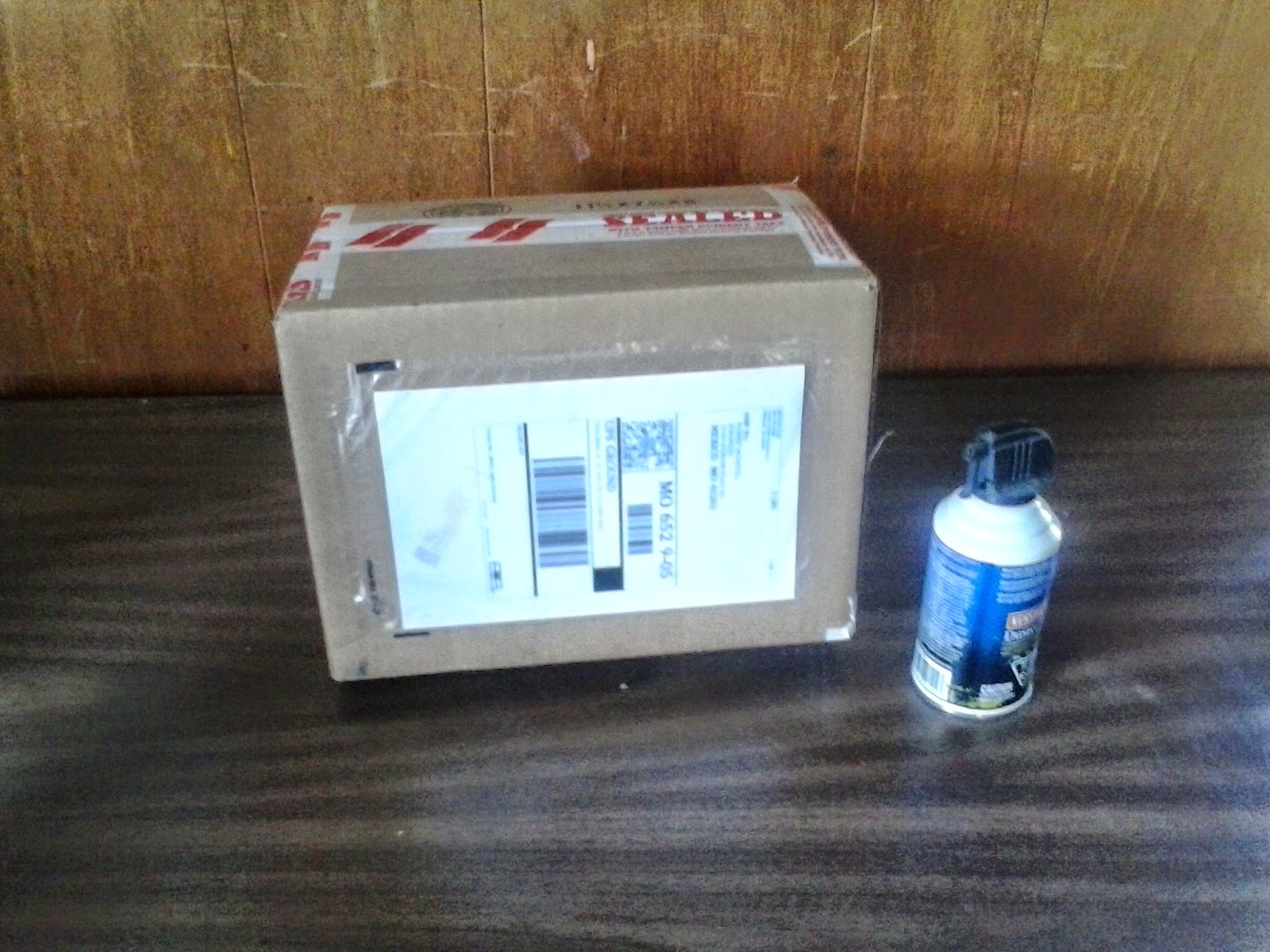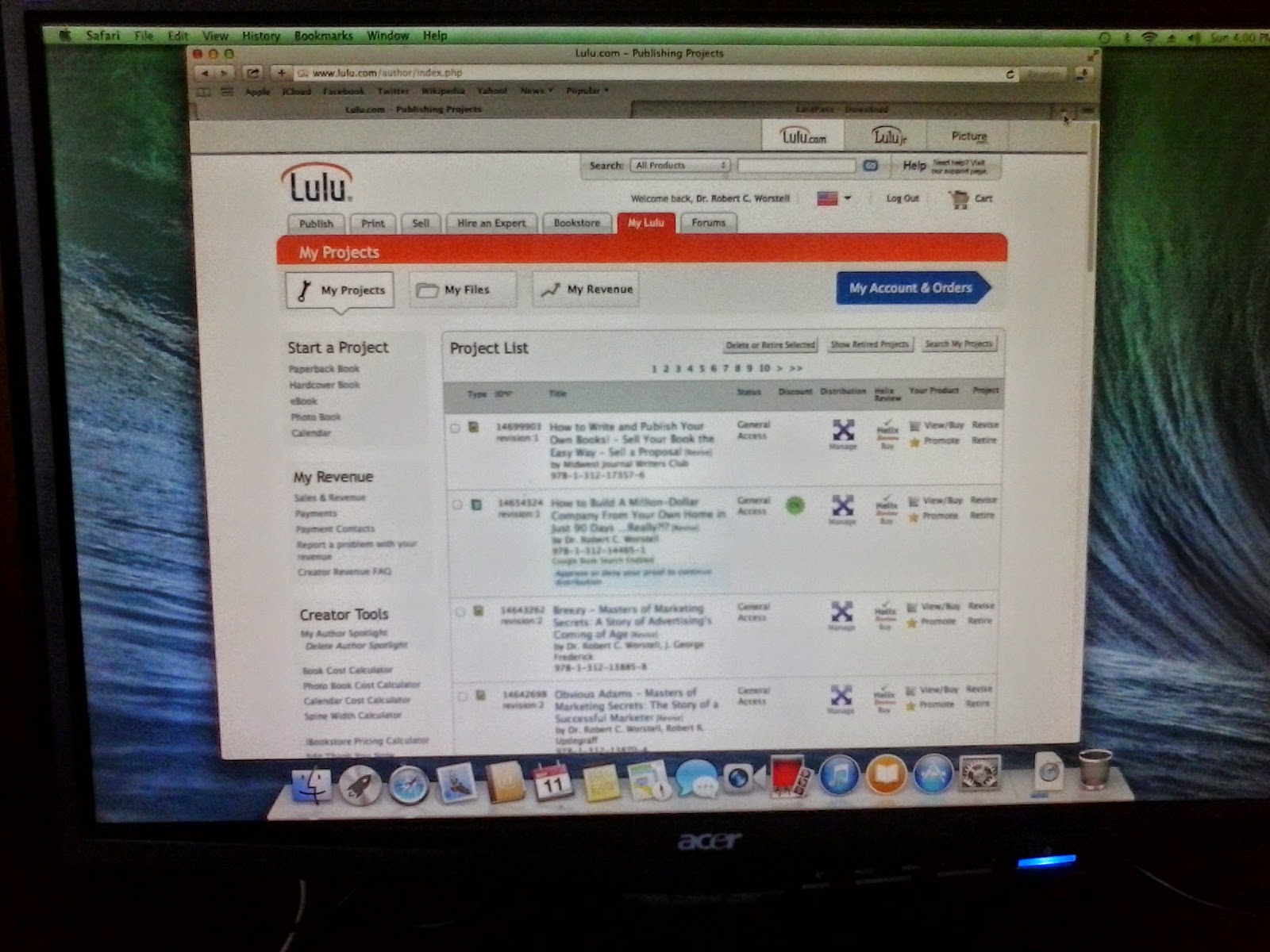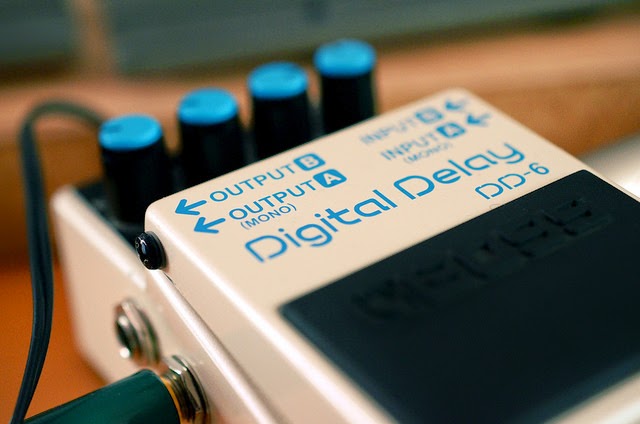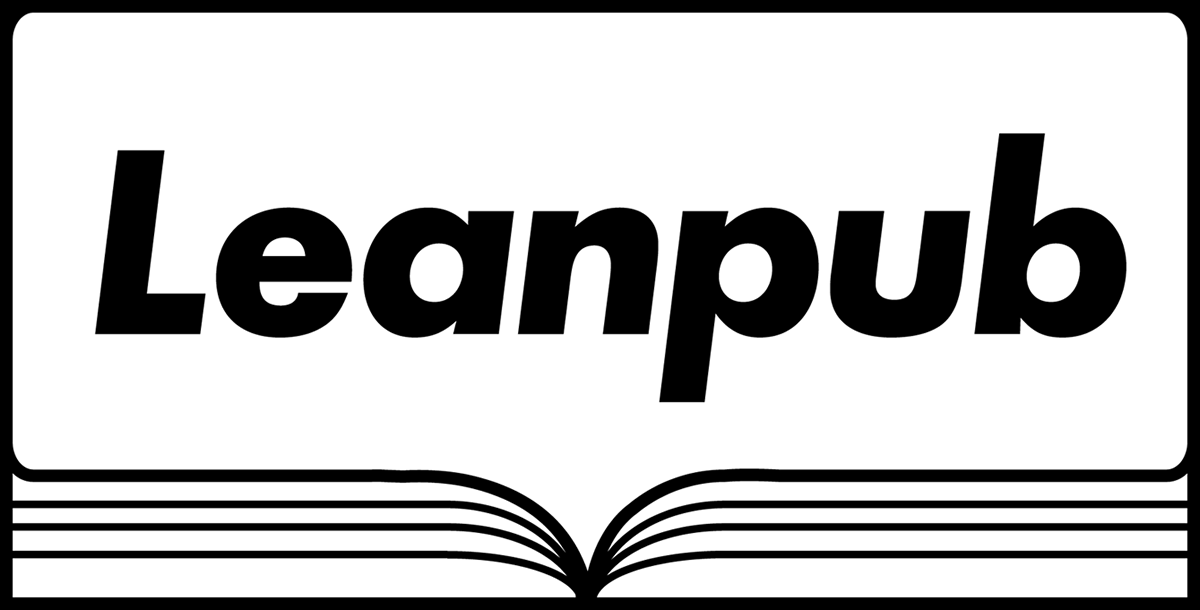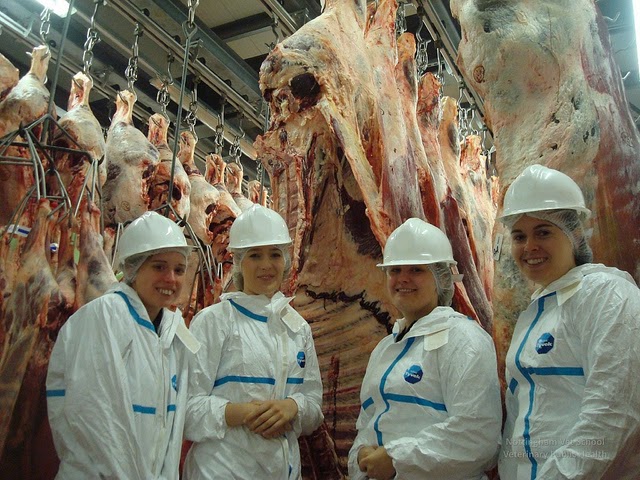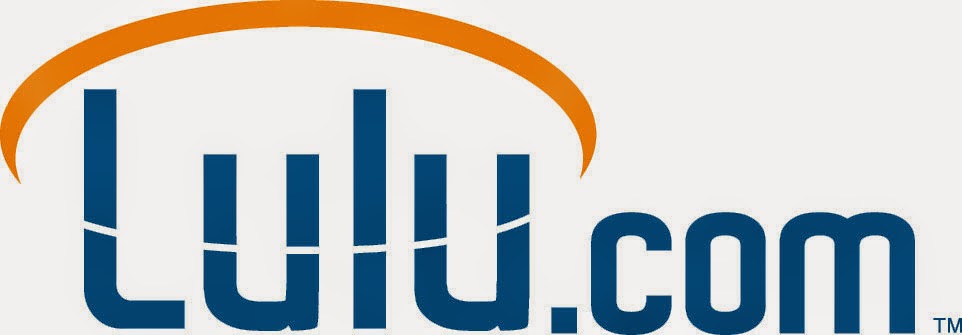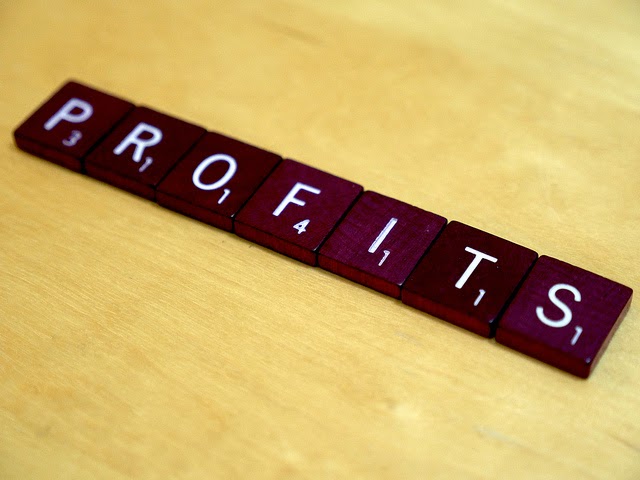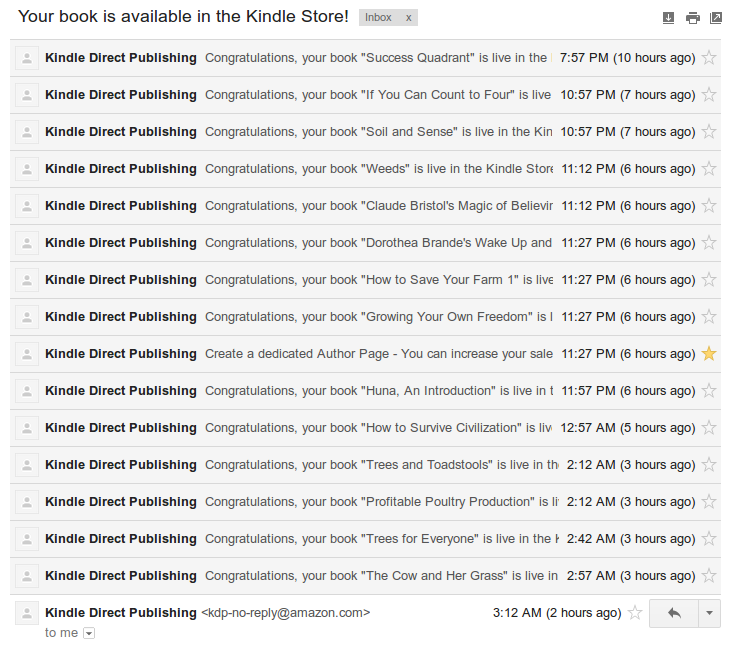It is possible to publish over 2 dozen ebooks to Amazon in an afternoon.
 |
| (photo: Alan Hudson) |
Of course, there’s a great deal of work to get to that point. Over 2 months of preps.
And you should see how many were left on the cutting room floor. Over 70 others I didn’t bother submitting.
It took that long and I had so many leftover – because I didn’t really do my homework before I started. This was learn-as-you-go, and also making use of books which got rejected on an earlier test.
The good part is that now I have (or will have, once the smoke clears) around another 20 – 30 books on Amazon to add to my passive income, which has already make me financially free. (Now, I’m following Jim Rohn‘s advice and concentrating on getting rich…)
The point of this celebration post is to tell you that it is possible, and to lay out how you can do it on your own.
This posting is, of course, yet another test. All these tests are narrowing the target and becoming more remunerative.
While these 30 books were all ebooks, I’ve spent the couple of months getting them ready – or more accurately, getting several versions of most of these ready.
What worked really well
0. Using Public Domain books as source material. The editing is much quicker – especially if you use good quality material and don’t spend a lot of time on proofing OCR errors. The point here is to find niches which need and can use this material. Then find high quality versions of them in one form or another and re-publish them with fresh, attractive covers and enticing descriptions. Part of this is to do the homework before you invest even minimal time on them. I’ll cover that below.
1. Getting the print versions published ahead of the ebooks. I was surprised to find out that my print books were already there for several of these ebooks I was just publishing. Not all, but several. (I didn’t create hardcopy versions for all of them, only the ones which seems to be most profitable.) It does take some weeks to get the proofs back and then approved.
This is a marketing advantage, since the paperback is always higher than the ebook, so it looks to be a bargain. Many people get the ebook first, then the paperback (as they can be easier to read than an ereader, just bulky.)
2. Looking over these books from Amazon’s perspective – giving them new identities, rather than worn commodities. This is what sorted out quite a few of them. I’d only done a straight edit, and then slapped on a nice cover and found a description to use. What is really needed is to study out the book you find, as well as your niche, so you can present what is factually needed.
Collections always work. New titles can work. Amazon is looking these over for duplicate titles/authors in their metadata. Giving them something new bypasses that scrutiny.
I also suspect that by having a publishing imprint, rather than my own copyright on these books, has helped them move more quickly through the process. These are all copyrighted and published by “Midwest Journal Press”. So it fits their model of a company coming along and finding these books, then pushing their version out. The other point is to take the 35%, as they are public domain sourced. Yes, they are technically your new copyright, but the agreement is to take the lower percentage if they are mostly public domain material. Don’t want to run afowl of Amazon, now do we – meanwhile, you can crank out several dozen or more books in a month, compared to writing a single book in that time (most authors will only do 2-3 new books a year, so…)
There has been some change on Amazon’s algorithms, as many were approved and available for sale before I was even done submitting. Very nice.
The key is to not give them anything which will alert them.
What needed improvement
This started as another bulk test. I had yet another bunch of PLR books I wanted to test, as well as a nice chunk of books on agriculture which I found while looking for answers about some of the farming questions I had.
Throwing these up via Lulu got them all stalled.
But I kept finding more books to work up. Mainly because this is the last big test (probably) that I’ll be doing. So I wanted to get everything wrapped up, as I’ll be hitting the marketing scene massively right after I get all this batch published.
a. Not doing full homework first. Which is simply searching for the title on Amazon itself. You’re looking for:
- Will they be able to get published on Amazon – so you can leverage the income from them?
- Are they actually public domain?
- Has someone already gotten them published there? (Many of these were published by Amazon themselves, at a $0 price point.)
- Is there a market for them, or are you just amusing yourself?
The general sequence in such a scene would be to verify that the niche you are interested in can be monetized by selling books. Most can, as the people in any niche are usually rank beginners and are looking for everything they can find to tell them how to succeed at this stuff. But is the money they can pay you enough to keep you interested?
In my case, it was:
- Publish the PLR as I already had it sitting around and this is a way to find out if people actually want the material you have. (I only published the material which already had good covers and the text was in decent shape.)
- If the PD books I had been downloading to answer my own questions about farming were in decent shape, then I’d create a new cover and description for them. Figuring that if I was interested in these, some one else was as well – and would pay me for them (hope springs eternal.)
b. Working from a large batch, and not watching for mission creep – which was compounded by my lack of homework.
It ended up being 101 books, total. That’s way too many. I’d say that 10 is a big batch, if you are going to do any real marketing after you’ve published them.
Again, I started with some PLR, which is a crap shoot, since no one knows if this stuff is worth anything. This accounted for around 40 of the titles. And you market the ones which sell, then decide to do something with the rest when you can get to them. So marketing is started only when the title in question develops some sales without any marketing besides the cover (which came with the book) and description. Amazon simply doesn’t accept PLR as ebooks. (Print versions are different.)
The public domain books were then about 60 books, and only half of them were able to be published on Amazon – as they weren’t distinctive enough.
Closer to the end of this project, I started in on testing print versions as simultaneous releases – so I was keeping a better eye out for books which would publish on Amazon:
- making collections
- changing titles (radically)
- finding a rare few which no one had ever made a Kindle version for.
c. Putting it off for fear of rejection.
When I had done this earlier, I had something like one in three being rejected. Of course, I then went back to find out what I’d been doing which caused the reject. Correcting this (making each book distinctive) gave me more courage to forge ahead.
As well, since I had built up a huge amount of books to submit, I had numbers in my favor. The key point was faith in what worked – which was the observation of others (plus my own testing to prove) that a “deep backbench” of books was the key to book income: Most books don’t sell well – some don’t sell at all – but a tiny handful sell extremely well.
Perhaps “fear” is too strong a word. But I really was avoiding the annoyance and extra work of the rejections.
d. In almost all these cases, I’m running blind in terms of marketing.
A small handful (about 6) out of these, I created collections to get these books onto Amazon. They are popular and sell well for me, but have other versions out there already. Those I had already worked up print versions for.
Another small set is following a passion point – the books fill a need which can be marketed. But doing this without a real marketing plan means, at worst, I will have some nice paperweights around my home-office to press leaves with, etc.
One nice scene was finding a very over-priced textbook which is a high-demand book. Now I have the hardback, paperback, and Kindle versions up – at lower price point. Just a little marketing should send most of this demand my way. (Again, that eternal hope, based on my own wants.)
You develop the marketing as you develop the product. There’s a great deal to sort out along this line. That’s the subject of my third and final book along this line. (Then I’ll make a collection of all three together, and hopefully they’ll start selling at that point – otherwise, a nice effort.)
The statistics so far:
- 70% failure on porting to Amazon. All 101 will be able to be posted to iTunes, Nook, Kobo, and Google.
- Of those 30 that made it, I still have a small handful which are in draft (typically for typo’s) and perhaps will have to field some questions tomorrow or by Monday. With this new script they have running, I don’t see getting much blowback on these.
- 12 are currently in Review or Draft. (I see that I already have 3 email queries to answer from these. So close to 50% immediate success, which is about 15% of the total I started with. And that’s just about 6 hours after I started submitting.
All this is much better than the last time I was submitting to Amazon. I’ve gotten better at submitting, and they’ve gotten better at reviewing and accepting.
Where to next?
The entire set of 100+ ebooks will get posted to the other distributors as noted above. Using Calibre, this is pretty much a cut/paste scene.
Out of those, I’ll then start getting some additional sales.
The hardcopy versions I’ve approved for distribution will also be tests of income. I’ve a few more to proof and approve, which will tend to back up ebook sales.
As these complete, I’ll then have built a decently deep backbench of authors and titles to afford the upcoming marketing of the smallish handful that routinely sell.
What about the rejects? None were key books I feel to be basic to my marketing approach. I can revisit them whenever I feel a test is needed. Now I know more of how to make them a success.
Real market analysis will be a next action.
The main approach is to get titles that should start generating list opt-in’s, such that I can start generating “instant Amazon bestsellers” by doing real releases for these books. Again, all this will build as I go. The backbench passive income will pay for investing it more extensive marketing costs.
Upcoming as part of that is a membership setup, which will then leverage all this content (as well as giving opportunities for other services) – even as I keep adding to it by linking in all these books, as well as creating low-cost digital and hardcopy versions. DVD’s also are on the horizon as additional products to offer.
Yes, there are several marketing tests which are going to be needed. So you can stay tuned for this (subscribe by email or RSS feed on the above right. The opt-in isn’t yet ready, sorry.)
Sidebar: Why all this work on ebooks when hardcopy versions show up on Amazon?
Short answer: Because ebooks and hardcopies help each other sell better. Ebooks are also cheaper and faster to create.
Right now, there is a boom on ebooks, which appears to be leveling off (depending on who you read.) More book sales means more of each.
Ebooks can also send people directly to your website to join your list – which is still the most effective way of monetizing your readers.
And the more you earn, the more you can help others improve their lives.
Update: The rejects
The speed of these acceptances shows that this is a near-automatic scene. Most rejects were kicked back or put on hold within that first few hours:
- 16 were approved right off.
- 12 are “in review”.
- 2 are “in draft” from spelling errors.
- 1 is “in draft” after being summarily rejected.
- 1 was blocked after being summarily rejected.
Those in review had titles very close, if not near identical to existing books.
3 books are needing some handling before they can be accepted.
The key word in the rejects is in “undifferentiated.”
One of the books which was rejected was simply put into “draft” mode. Nice, as I can then edit it into some other shape. Essentially, combine it with another book and re-title.
Update2: at nearly 24 hours, I still have
- 8 “in review” – 3 of these have been queried to me.
- 5 are in draft, one with uncorrected typo’s, the other 4 rejected.
- 15 are Live on Amazon Kindle
- 1 was blocked.
Of 29 books submitted, I’m still potentially able to get 24 Live on Amazon within the next several days (figuring that publishing on Thursday gave them a problem, since 5 of the 8 in review have not been responded to – probably needing human attention.)
Legal issues will get you rejects.
The one that was blocked I strongly suspect has some sort of prior legal claim on it. A similar book with a different title had a lawyer contact me about a trademark infringement, so I pulled it back and retitled. Much earlier this year, I had mistakenly posted books which had actually been under copyright, as I found from re-researching them. Those two books were blocked as I had used the content and title for these two (now-blocked) books.
In this current case, the book is in public domain, but that doesn’t stop the lawyers from threatening – which Amazon and any large corporation will avoid. Funny enough, the trade-paperback is up on Amazon – but they aren’t the publisher for that one, so it’s not on them. (The lawyer who emailed me seemed intent on badgering any new publication of that public domain work from showing up.)
This new version had two additional titles included as a collection, so it wasn’t a case of being “undifferentiated.” The legal restraint explanation seems to hold the most water.
(Update: In a search on Amazon, I’m finding that it looks like that particular title is slowly being eradicated on Kindle by the lawyers. Where there were several different versions available a month ago, mostly this has narrowed down to almost only books by the client those lawyers represent. Apparently.)
When they don’t think your book is different enough (Update)
Again, Amazon wants unique books. “Differentiated” is their term.
Here’s what they said about another three of them:
Differentiated books must include (Translated), (Annotated), or (Illustrated) in the title field. For example, “Pride and Prejudice (Annotated)” is acceptable, while “Pride and Prejudice (With an Introduction by Tiffany Gordon)” is not.
While it’s possible that other features may make books unique, we only allow the criteria noted above. Examples not considered differentiated include a linked table of contents, formatting improvements, collections, sales rank, price, freely available Internet content, etc.
If your book conforms to one or more of the criteria listed above, please edit your book details to reflect this differentiation by updating the title, and resubmitting it for publishing following the instructions provided below.
Claiming differentiation when your book is not sufficiently differentiated may lead to account termination or loss of access to KDP optional services.
Mainly, a search on their site would have predicted this. If you have more than two others, you are going to have to do something different. Right now, the best solution is to combine books into collections (binders) and title them as completely unique as possible – again, a search on Amazon will tell you this.
These three books had similar, but not identical titles – close enough for Amazon to say, “Close, but try again.”
The Amazon PD solution seems to be collections.
This is simply done in Calibre with the epubmerge plug-in. Just edit these after you are done merging – such as converting it to html and then opening that file up in LibreOffice to convert via Writer2Epub plug in. (It’s so easy, I almost started setting all these up with new versions – a perfect solution for the books I already didn’t submit based on competition.)
For instance, two dairy books make one decent one. Two agriculture textbooks make a nice fat one. Two books on raising vegetables and “fast cash crops” combine for a new binder with a different approach. My favorite one is two early books on horses – one on breaking wild horses, with another on how ladies ride sidesaddle – becomes, “Wild Horse Taming, Simple Training, and Elegant Riding – A Guide for Horsewomen and their Gentlemen: Two Classics with Practical Methods and Preferred Etiquette”.
Frankly, I don’t have any more time for this right now. I could see that this takes me down a line of work (rabbit hole) which distracts from the immediate goal of simply getting these books published and out (more mission creep).
What the above does tell me is how to publish books which are similar, but need to be differentiated from other works there – even where Amazon doesn’t have their own copy available.
The rule is – if you are using the same title or close, include “(Annotated)” or “(Illustrated)” in your book title per their instructions.
Again, I’m already over my head with work, so this will be another time – and you can expect a follow-up blog post…
Competing with Amazon will get you rejects
One interesting note is that two books I submitted are well-known to be in the public domain, but these were queried by Amazon. But interestingly, they asked for my proof of my license to publish them. I found that they have been selling these books on Kindle and making a nice profit from them. No, they probably don’t have any particular proof of their right to publish them, either.
The solution to this is to treat them as public domain per their requirements – add material and make them “annotated”. Since I already have added an additional essay to each, this should be a simple matter. Or, I can simply combine the two into a single book collection, or combine other short books with them.
Lots of solutions when you know what rules to play by.
The timing says it’s more computer than person doing the sorting.
Statistically, nearly 50% were approved right off. I have notices for three books which can simply be answered, which should put them in the right. I suspect that the rest of that dozen in review will all either pass (after a probable human review) or need some minor “herding” through.
Of note is that the algorithms seem to run in batches:
The first on that list was a minor edit I did for a price-change, which was before I started adding the new books. Most of them started coming in just as I was quitting for the night, about 7 hours after I’d started.
I suspect that sometime today the rest will show up in one column or the other.
Thick skin, hard shell, whatever – PD publishing is brave work.
And it’s really a numbers game. The more books you have up there, the greater chance you are finding and giving value which someone will appreciate. Commodity approach to publishing won’t cut it – there are already free versions out there. Ebook readers are getting tired of free – they don’t read them right off, if at all, just no value in them. Stick to paid books as they are more valuable.
This project review: starting with just over 100 books:
- 40 were self-rejected as being PLR. I’ve looked this up – they simply don’t make it on Amazon.
- Another 30 were self-rejected after I checked to see if I wasn’t giving them the same title and book already there.
- 3 have hit the review pile – needing queries answered.
- Only two have been summarily rejected – which is around 7 percent of the 30 I published.
- There are still around 12 more which are in limbo at this writing, just under 50%.
- The other 50% (about 15% of the total I started with) are now live on Amazon.
So I successfully published 15 books in a handful of hours, with another dozen in the wings, ready to take flight. Months of work in publishing gave me a complete education on how to break into the biggest bookseller with other author’s works.
The trick is to have your vision and hold it in front of you all the time.
You do indeed make your own reality.
What’s next in publishing?
Other than shepherding these remaining few through Amazon, I’ll be back to bulk publishing shortly.
As I noted, all the others will take these books with no problem: Kobo, Nook, iTunes, Google. They just don’t do hardcopy versions – but will link to them.
I’ve already started with Google, since that’s a simple bulk upload, and they do differentiate by meta-data and don’t reject.
With Calibre holding the data, it will be a simple scene of just porting each book to each distributor. Work, yes, but in this volume, they should start paying off within the month.
Again, the great point here is the passive income which keeps coming after I did the original work.
After all the dust settles from this publishing, then I’ll be getting into marketing for real. There are some very simple point of posting their covers with links, going to OpenLibrary to update about the titles I’ve just published – and leave more links. There’s the landing pages for these books to update.
When you really look over marketing, book publishing becomes a small part of the whole media production scene. Yes, I’ll still be publishing books, but not individually or with a shotgun approach. The next ones will be part of a media production roll-out/launch.
Books aren’t a path to success, but they make great stepping stones. (So get out the concrete mix, we’ve got some muddy spaces ahead to travel over…)
Some publishing-on-Kindle takeaways:
Know the rules, and know if they are following them. For the most part, Amazon applies what’s convenient for them. Too many competitors, and they reject your book as yet another commodity they already have. Legal issues unseen may block your project. Competing with Amazon itself may get your book rejected.
- If you find a book which isn’t on Kindle, get your ebook up there and it should sail through.
- If you have an ebook which Amazon is already giving away, then either
a) make a collection by combining it with another book and radically change the title – or
b) follow their annotated/illustrated/translated approach
- But note that just because it’s a PD book, you don’t have to declare it as such to get it on Kindle. None of the above were declared to be PD, but I also didn’t take the 70% royalty and published under an imprint, not a person’s name. That may or may not matter, your mileage may/will vary.
My potential of 82% publishing success rate on top of these lessons was encouraging.
Now I can get back to publishing all these original 100 books on the other four distributors.
Update – 24 hours later:
It’s been very nearly 24 hours now since I wrapped up my submissions. I finally heard back around dinner time on the other 5 books held in review.
In each case, they asked me to either verify I had publishing rights or that the books were in the public domain. All of these books except one were collections, meaning they had at least 3 authors (one had 6) – so I then had to find a site which said when the author died, and when they published their book for every single author. Since many were post 1923 and pre-1964, I had to then give the Stanford database link to show that they’d never renewed their copyright (proving a negative is sometimes impossible.)
Amazon is the only distributor which does this. This is exactly why I didn’t want to jump into this scene with them. PITA. But now I’ve answered all their questions and these should all now be approved. I’ll have two books to edit so that they are no longer competing with Amazon as Kindle books, and then I’m done.
Thought I’d be working on another distributor by now – but having all my books reviewed within 24 hours is probably the drill which will need to be expected.
Addtitional rule out of this – where possible, create the book’s landing page ahead of time for that book with the links you need, especially for the collections. Then it’s sending them only a single link with everything laid out. A bit anal, yes. Book publishing is full of details. You already do the research – just note it down somewhere so you can get back to it – like Calibre.
I did have to make such a page for one of my books – the rest allowed me to simply send them the links in an email. Only Amazon. Sigh.
Update – over 48 hours later:
Now its
- 16 approved and live
- 7 in review
- 5 in draft
- 1 blocked
Breakdown:
- All the books which were not represented on Kindle were approved right off. Meaning the title was distinctly different from anything they already had.
- 4 of the books which were too similar to Amazon’s free Kindle books were returned to draft. (The fifth book in draft has a typo, even though this particular book was also queried to me.)
- 1 book with an apparent (and unknown) legal problem in the title was blocked (see below).
- 3 books were queried on the basis of publishing rights – meaning Amazon itself was the only author selling a version on Kindle. (All of these books were public domain, but their query was publishing rights.)
- 5 out of the 10 collections I posted were queried.
Additional data came to light – that Amazon wants a single URL for each book which gives the author date of death and first published data. This can simply go into the landing page you were building anyway – like at the bottom. These links generally go to Wikipedia or OpenLibrary.org, so will just increase the authority of your page anyway. (Giving them the link in response to their email simply got a succinct request for the single URL.) More than likely, you simply need to respond with that URL to begin with.
Update – nearly 72 hours later
- 19 live
- 4 in review
- 4 in draft
- 2 blocked
We are running up against/over Amazon’s own limits to reviewing books. I’ve asked (again) that two of these in review be returned to edit mode so I can “fix” them. I re-sent the URL’s for the other two books.
The books remaining in review all have problems:
- Two are only sold by Amazon, no competitors – I’ve asked these to be returned.
- One is a collection of classic erotica, with a suggestive cover – may violate their “porn” policy.
- The last has pages and pages of Kindle competitors – none are collections of three books into one.
On the face of it, I can understand if all are rejected. I could also understand all of them being approved. Either way, it’s been a real learning experience. (And has backed up why I haven’t been too keen to publish on Amazon. Prior research and homework would have made a much simpler experience – but that is what tests are for.)
Final update – over 96 hours since I started:
- Only 2 left in review.
- 2 were sent back to draft making 6
- 19 live
- 2 blocked.
The email I got back a couple of hours ago (just opened) said for me to re-send a URL which gave the public domain status of those two book still in review.
I checked, and the other two books were back in draft, as I’d requested.
At this point, I simply asked them to put the other two books back to draft so I could remove them. I’ll probably leave them in draft until I have time to get back to this. Obviously, I overloaded their system. And got tired of the hassles.
Results: 19 out of 30 were approved. The others weren’t so lucky. End of test. Lots of lessons learned.
Note: Another solution is coming out of this – how to sell books directly from my own site and also give the links to other distributors. Meaning anyone can get the books which Amazon won’t offer – and be able to load these into the Kindle reader. I also get 90% royalties!
Meanwhile, I can also offer the PDF for sale – basically any digital product. Nice. And bundles of things. Very nice. Free to set up, they’re paid by your sales. Paypal or credit card. Very, very nice. Blog post upcoming…
Takeaway –
- Search on Amazon first, even before starting your editing. You need to know if you need to build a collection and how wildly different your title needs to be.
- Build your landing page before submitting your book. Always. Collect the author’s death and first published data as you check for copyrights. Hold this data in Calibre, along with the links – or a text file you won’t delete somwhere. You could also build a “for record” (draft) blog post to start with, and then flesh this out with the cover and description – as well as buying links – when these become available.
- Keep your batches small(ish).
How this affects your sequence of publishing and marketing
Generally, you follow your bliss. You can collect up a bunch of books you thing would help, and then research them to see if they pass, based on a) copyright data b) Amazon competition.
- Keep your batch to 10 or less books.
- Take only those which pass as public domain. You may find orphans, but you won’t be able to get them through Amazon, as they’ll ask you for proof of publishing rights – which you can’t provide, as the author is dead (and usually that publishing firm as well.)
- Books that are only being sold by Amazon on Kindle are going to get some scrutiny. Also, where Amazon is giving the free version away.
- Amazon research will tell you your title – or inspire you for it. Mentioning another existing book title even in your subtitle will alert their algorithms.
- Save all your the above research data to Calibre, so you can build your landing pages before you publish. A draft (not live) page with this data and hard links would help.
- Finalize your marketing approach preferably before you start editing, and then tweak it as you go.
- Part of this marketing is to survey your biggest affiliate partners to see when your launch would work in with their schedule.
- Publish in Lulu first, to get their ISBN’s (unless you’re buying your own).
- Get your hardcover approved first, which takes weeks due to proofing.
- If you are setting these up for pre-publishing sales, this has to be started with Lulu, and then continued with all the distributors you port to later. You don’t have to send these books out to wide distribution (Global Reach) from Lulu until you’re ready. Also, make some hardback versions which are Private Access and lower price just for your “velvet rope people” (mailing list).
- Build your landing pages for all books, and save them to draft. If Amazon needs that URL to verify your book, it can be set to Private Access.
- Publish to Amazon, Google, iTunes, Nook, and Kobo. Do each distributor one at a time, preferably in the order of greatest meta-data required – so later ports go faster. The order above generally seems the simplest.
- Get all your book launch material ready. Opt-in forms, ecourses, video’s, etc.
- Announce to affiliate sales people to get more in on the launch.
- Do your pre-launch promotion.
- Do your launch promotion.
- Pay your affiliates in full and get their feedback.
- Do your post-mortem analysis after the launch is complete.
The emphasis on Amazon research is because this is the biggest leverage you have on that book’s income.
The reason for also publishing everywhere else is to not leave money on the table. No distributor’s audience matches the others. You may not make as much money as on Amazon – or you may make more.
Another reason is to let the search engines know, spreading link-love from one to the other, and taking multiple spots on Google’s front page for that search.
An initial price of .99 will get you the reviews, and then your price goes up once the release is off. (You can also send them PDF or epub versions once they send you a copy of their receipt for buying on Amazon. Maybe even a hardcopy version – for the first 25-50-100 or so.)
You’ll then have follow-up releases for the next books in this series, as well as collections of part or all of the books. With the email list you have of buyers, you can simply make each one an “Amazon bestseller”.
After all of this, you also can then do a release to affiliates, with a bundle of all these digital properties and the videos, etc. Low price during the release, and then it rises up to the full price – until you do another launch, where people get a special offer, or you take down the bundle temporarily. These make your launches evergreen – meaning that they earn you more income all year ’round.
Properly done, you’ll make more income with affiliate sales than on Amazon. But getting a bestseller on Amazon will help your affiliate sales take off.
I don’t cover the idea of running paid courses or a paid membership. The more books you have, the more material you can offer, the more income you can make. The key approach is to market as you go, getting all you can from every book you publish. (Do as I say, not as I’ve done. But someone had to scout this trail, didn’t I?)
– – – –
There’s a lot more details to this marketing approach – these are just the highlights. I’ve got a lot more blog posts to do. This one is way too long – it’s a place to lay everything out as part of an upcoming book. Print it out as a PDF or hardcopy and mark it up for study.
Again, don’t get serious over this. Books are stepping stones on your journey, not any key make-or-break point of your life. We are moving from self-published author to indie publisher to media producer.
Enjoy the journey.
– – – –
13/3 – Final Final Update (hopefully.)
Got a brainstorm this afternoon to go back to cross-check those emails. It seemed significant that some emails were signed and some not.
When I put them all on a spreadsheet, it became pretty obvious:
A computer algorithm is handling all the initial requests (the no-name responses). If the title is decidedly different from anything they already have, then they let it through.
If there is any query, you’ll get a personal email after you reply.
But the automatic query can still ask a few things:
- If the title is close to a PD book they already have, then it’s rejected as needing to be “differentiated” and put as draft.
- If there are legal problems, you’ll be either blocked directly (and told it wasn’t differentiated enough) or queried for publishing rights. If your book still lives, then politely request it be put back to “edit” mode so you can delete it. (And yes, then promptly delete it – tell you why in a second.)
- If they ask for information about the author death date and first publication date, then give them a URL with this information. Otherwise, they’ll simply ask for a URL in the next email.
Note: These automatic queries all came after a delay of some hours after the original approvals, most the next day (which could have been early am.)
After you respond, as I said above, the next query email would be from a real person, however their pat responses are all cut/paste unless you ask them a direct question.
- They will ask for a URL as it’s apparent that the books are built from public domain content. (7 out of 29.)
- They will ask for proof of publishing rights. (Twice out of 29.)
- They will tell you your book isn’t differentiated and block it. (Once twice of 29.) You won’t know about the legal problems until after your book is blocked – and even then, it’s a supposition. They only say “not differentiated” or “not publish at this time.” But it’s blocked either way.
If you don’t give them a URL, or give them a URL where it’s not obvious about the data they want, then they may ask you again. The funny part happened when I told them to simply return them to draft so I could edit them. Something kicked in with the auto-computer and the books wound up blocked as “I hadn’t given them the URL in five days.” When I quoted their email back, they again put it in draft – where I promptly deleted them (along with everything else in draft.)
You don’t want to mess with these guys. Every single email has that threat that they’ll cancel your account if you keep up sending them questionable books.
Publishing public domain is a very fine road. With a steep drop-off on both sides.
I even found one of my books was auto-approved and then later was simply “not available for sale.” So I put it back into draft on my own. Something not quite right about that book – again, I didn’t research what was out there – so it’s probably duplicate in content, if not in title, to something else. The computer algorithm erred, so they simply put it into a quiet blacklist status. Result is the same – it’s not available for sale.
Bottom line: Research everything before you post anything. Change the titles utterly – it seems that subtitles and series count as the whole title. Look for duplicate content to yours.
No, you won’t know about the legal hassles Amazon has already been through. But when you have extremely popular books, with lots of copies available – on both hardback as well as Kindle, then you should probably leave it alone – or publish an extensive study gude, an original work.
Original works are always wanted – only as long as you don’t duplicate someone else’s title.









